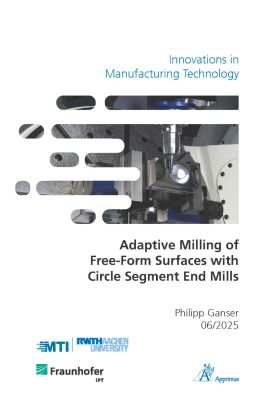Due to its high geometric flexibility, productivity and achievable product quality, milling is a key technology in metalworking and is widely used in industries such as aerospace, die and mold making or semiconductor industries. In milling, increasingly complex product designs and rising quality requirements are leading to the growing use of 5-axis milling processes. The state of the art in finishing milling of complex features such as free-form surfaces is milling with ball end mills, which offer high geometric flexibility but have limited productivity due to the short step-over distance required for sufficient surface quality. An alternative is milling with so-called circle segment end mills, also known as barrel tools, characterised by a lateral circle segment contour with a significantly larger radius compared to a standard ball end mill. Circle segment end mills enable a significant increase in productivity due to larger step-over distances with the same or even better surface quality. However, circle segment end mills have so far only been used to a limited extent by industrial end users. The main reasons for the low level of acceptance are complex tool design and tool path calculation, as well as strong fluctuations in machinability criteria such as process forces, particularly on free-form surfaces.
Against the background described, this thesis investigates approaches for the adaptive milling of free-form surfaces with circle segment end mills, in particular to reduce fluctuations in the machinability criteria. In basic milling tests, the machinability criteria are investigated as a function of different surface topographies and process parameters and compared with ball end milling. For the simulation of milling operations with circle segment end mills, a high-precision mechanistic engagement and force simulation is modified and subjected to a comprehensive validation and sensitivity study with regard to different model configurations and calibration approaches. Using the simulation capabilities obtained, the causes of variations in machinability criteria are identified, suitable process rules for their avoidance are derived and implemented in adaptive milling strategies, supported by corresponding aspects of tool path calculation. The validation of the CAM-integrated, adaptive milling strategies is carried out using a free-form surface demonstrator. The work presented is intended to support the industrial use of circle segment end mills.
Prozesstechnologie
Adaptive Milling of Free-Form Surfaces with Circle Segment End Mills
Kurzbeschreibung
This thesis investigates the adaptive milling of free-form surfaces with circle segment end mills to improve machinability. Basic milling tests and a high-precision mechanistic engagement and force simulation are used to analyze the influence of surface topography and tool orientation on machinability. Process rules are derived to reduce force fluctuations and implemented in CAM-based strategies to enhance productivity and support the industrial application of circle segment end mills.

